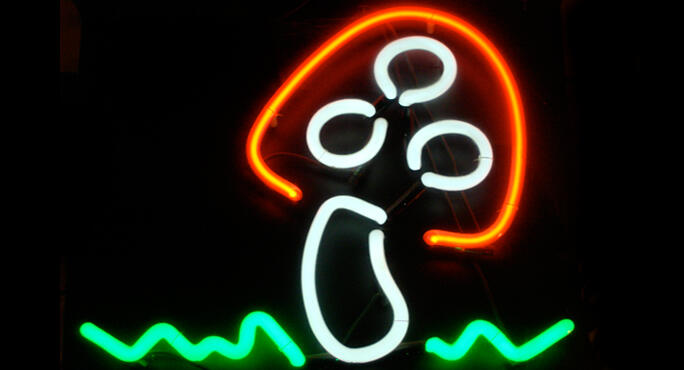Common Name
Botanical Name
On May 13, 1957, an article on the cover of Life Magazine written by a vice president of the Wall Street banking firm J.P Morgan ignited the psychedelic revolution.
In 1955, R. Gordon Wasson and his wife Valentina, journeyed to southern Mexico, where they encountered a native woman named Maria Sabena, who conducted sacred ceremonies employing hallucinogenic mushrooms. The first non-natives known to participate in these rituals, the Wassons were pioneers in consciousness exploration through the use of natural mind-altering agents. Writing about his experiences with the mushrooms, Wasson penned the now-famous article "Seeking the Magic Mushroom."
Not long after the Life article appeared, others traveled to the mountains of Oaxaca to find out about the sacred mushrooms for themselves. Among them were notables including Timothy Leary, Allen Ginsberg, and William Burroughs. Word spread about the strange fungi, and people who made the trek to southern Mexico enjoyed fantastic visions and surreal experiences while under the influence of "magic mushrooms".
When the hippy movement broke out in full bloom in the 1960s one agent of change in the trick bag of the movement was magic mushrooms. The other big hallucinogen of the time was LSD, originally discovered in the laboratories of Sandoz Pharmaceuticals in Basel, Switzerland, by chemist Albert Hofmann. Dr. Hofmann took up analysis of the magic mushrooms, finding in them two alkaloids, psilocybin and psilocin.
Going further, Hofmann was able to synthesize psilocybin, thus creating a modern laboratory version of magic mushrooms. With Hofmann’s discovery, it was possible to consume psilocybin in the comfort of one’s own home (or in a field of flowers), and experience visions and fantastic phenomena. Psilocybin became a staple drug of the psychedelic 60s, though it took a back seat in popularity to LSD.
The widespread use of hallucinogens in the 60s and early 70s caused a furor, and eventually psilocybin and magic mushrooms became Schedule I substances. Their possession, sale or use became felonies, and many tripsters wound up in jail.
Recent studies, however, show that psilocybin, the hallucinogenic agent in magic mushrooms, can be highly beneficial. The most recent study, reported in the September issue of Archives of General Psychiatry, involved patients with advanced stage cancer. Twelve adult patients were given psilocybin, and then were subsequently monitored for 6 months afterwards for overall mood and anxiety. No adverse effects among the participants were reported. But anxiety was greatly reduced, and patients were less depressed. This study demonstrates that magic mushrooms, or more specifically their active agent psilocybin, can be useful in reducing the anxiety and depression of the terminally ill. Perhaps as time goes on the use of psilocybin among the terminally ill may be deemed a mercy medicine.
Even more remarkable, and certainly with broader applications, is the 2006 Johns Hopkins study, reported in the journal Psychopharmacology. Employing rigorous scientific conditions and measures, researchers at Johns Hopkins Medical conducted a study showing that psilocybin can induce mystical/spiritual experiences of great worth and of enduring effect. In their study, 36 healthy, well-educated volunteers — most of them middle-aged and with no family history of psychosis or bipolar disorder were selected. The subjects were given psilocybin in a controlled clinical setting. Among the volunteers, 22 had a “complete” mystical experience. After a two month follow-up, 67 percent of the subjects rated the experience "the single most meaningful experience" of their lives, or among the top five most meaningful "experiences."
These are staggering results from the ingestion of a small capsule.
Since the harsh crackdown on hallucinogens in the 1970s, researchers have pressed to continue to explore the potential benefits of various hallucinogens, including LSD, Peyote, psilocybin, and the Amazon brew ayahuasca. But only in recent years has the climate for such research thawed sufficiently enough to actually conduct studies. Now we are seeing evidence that exactly as described by traditional healers, these agents do in fact offer benefits for mind and mood.
Interesting enough, magic mushrooms, peyote buttons and the ayahuasca brew are all referred to by those who employ them as “The Medicine,” for their broad purported healing benefits.
The recent highly controlled, rigorously conducted medical studies on psilocybin show benefits indeed. Some critics worry that the mystical experiences described in the John Hopkins study represent a “God in a bottle,” and that this challenges the role of traditional church-based religious practices. Yet others perceive the same mystical experiences as deeply beneficial, contributing to a more whole sense of self and of one’s place in a vast universe.
One thing is for certain. The psychedelic genie is now officially out of the bottle, and the beneficial effects of magic mushrooms are being discussed in hospitals and clinics, and in regulatory offices. Don’t expect magic mushrooms to show up in your home pharmacy any time soon. But do expect more good news on the psychedelic frontier, as researchers continue to conduct medical studies that pry into how mushrooms and other psychoactive agents from antiquity may play key roles in health and happiness in the modern world.
Medicine Hunter Chris Kilham, for Fox News Health, October 26, 2010


